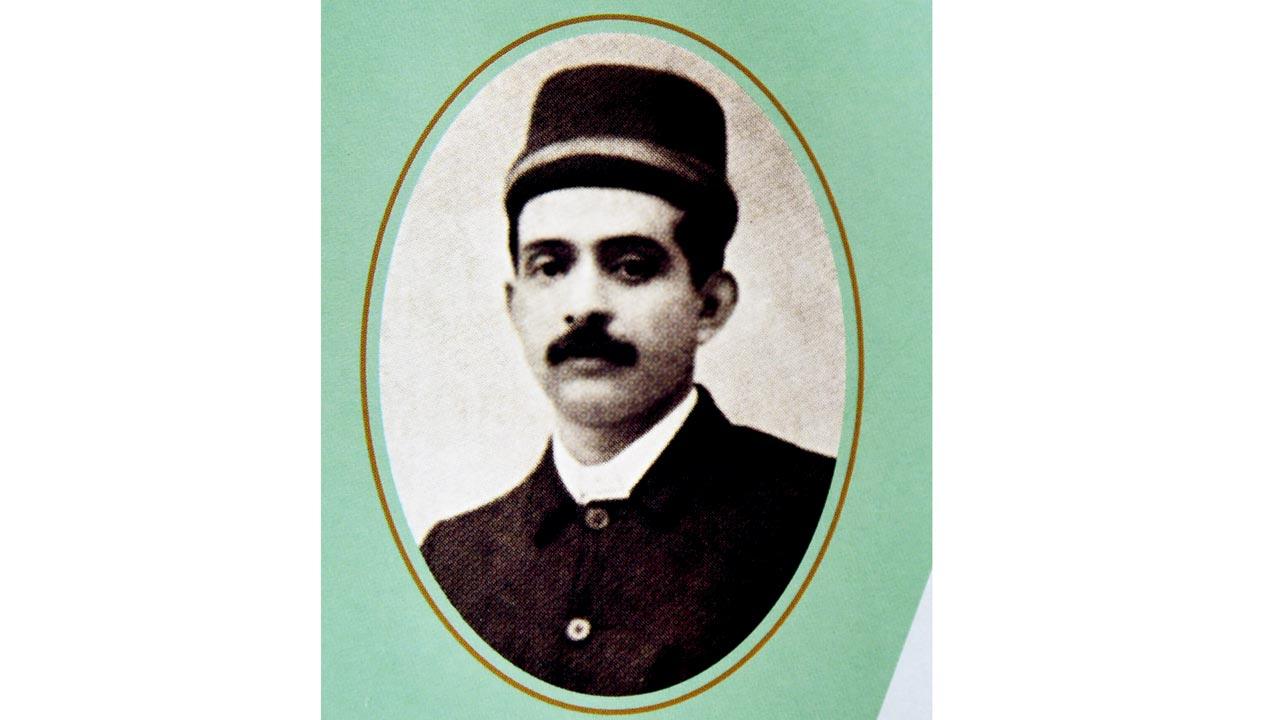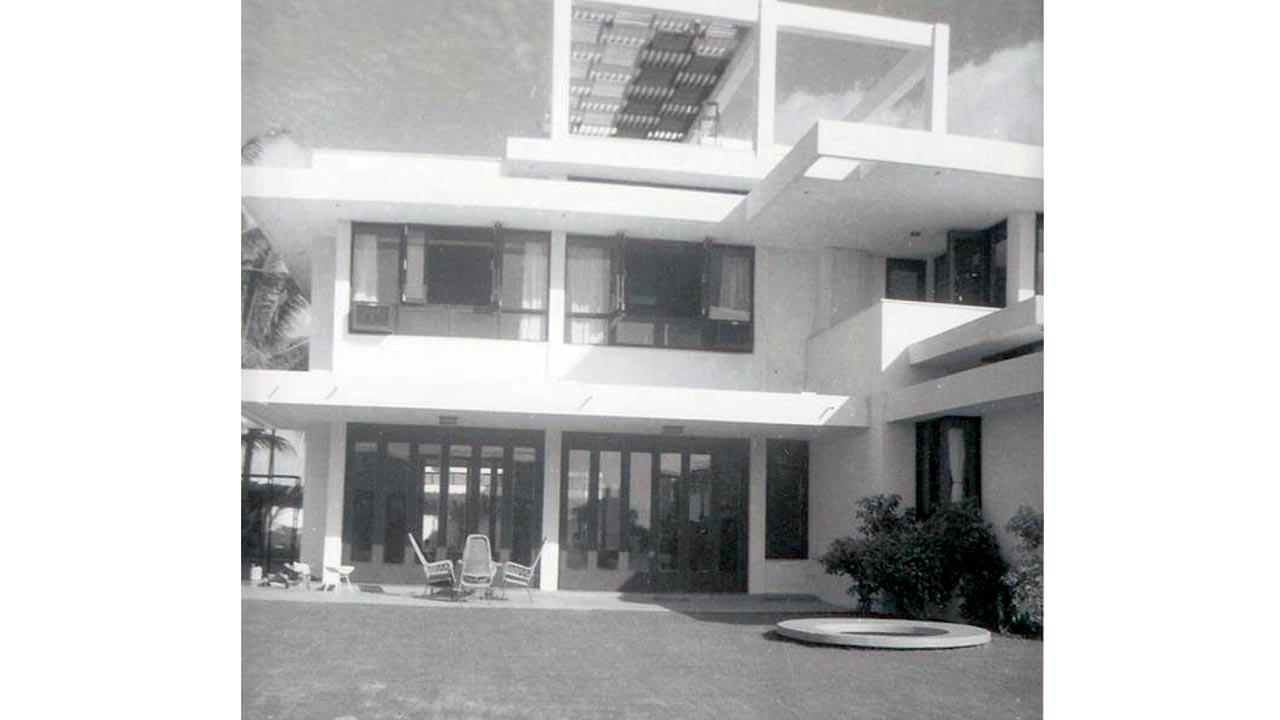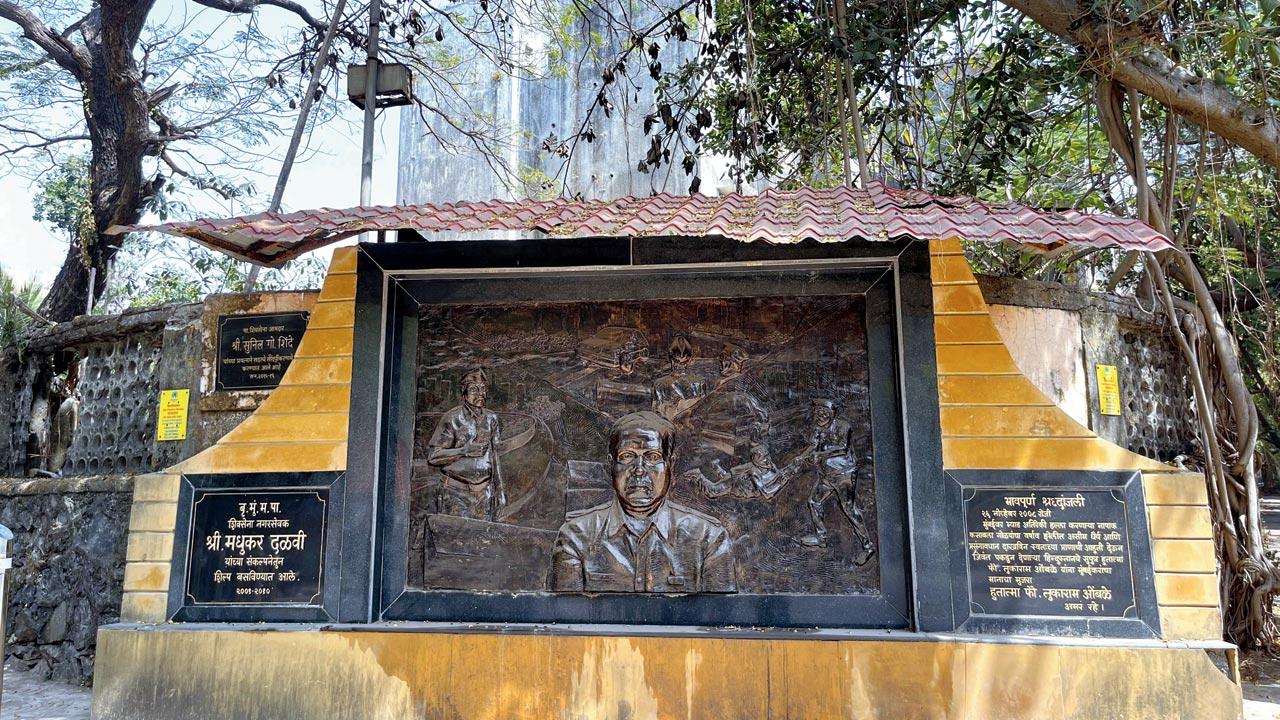Sir Sorabji Pochkhanawala Road presents a rich mix of histories—contributing to Worli, state and country

Cousins Shahrook Munsiff and Farhad Pochkhanawala stand before Buena Vista. Pic/Atul Kamble
 This is that fascinating road where the country’s banking history meets police history, and freedom history meets art history. A convergence of wide and varied narratives as emotional as they are engaging.
This is that fascinating road where the country’s banking history meets police history, and freedom history meets art history. A convergence of wide and varied narratives as emotional as they are engaging.
ADVERTISEMENT
British soldiers en route the East, especially to Burma, halted in barracks on Pochkhanawala Road, behind the Worli promenade. These were converted into police barracks post-Independence and then the Armed Police guard division, whose members exercised on the parade grounds. This stretch is now home to the Traffic Police Headquarters, mapping the city’s vehicular grid.
An interesting family lends this street its name. In 1911, Sir Sorabji Pochkhanawala founded the country’s first Swadeshi bank, Central Bank of India, pitched determinedly against the British-dominated banking system. Saker Apartments and Om Ratan, named after his wife and younger son respectively, skirt the Pochkhanawalas’ ancestral seat, Buena Vista.
 Sir Sorabji Pochkhanawala, founder of the Central Bank of India
Sir Sorabji Pochkhanawala, founder of the Central Bank of India
The road’s first building in the 1930s, Buena Vista had verdant gardens sprawl at the site of Saker Apartments. Om Ratan rose where its badminton courts previously stood, behind the tennis courts. Cobras slithering down the Worli Hill dongar of red mud and laterite rock were drawn out of the soil by snake charmers.
“Our garden had champa, badam and jambul trees. My grandfather constantly battled kids of policemen knocking down the fruit,” laughs Farhad Pochkhanawala, whose father Noshir was Sorabji’s older son. “Lamp-posts doubled as wickets for gully cricket and study spots from sunset. On the seafront, we weren’t allowed to wander near the jail, which later became the dairy. And we were strictly warned never to ride in Dr Phil (Phiroze) Banaji’s speeding silver Jaguar.”
Farhad remembers his legendary aunt, Pilloo Pochkhanawala, encouraged him to model clay while she welded experimental masterpieces in material like scrap metal. Among her brilliant public works, Spark, installed at the old Haji Ali Circle, was supposedly named so on account of being commissioned by the BEST.
 Alpana Piramal Chinai with her parents, Vijaya and Dr Mohanlal
Alpana Piramal Chinai with her parents, Vijaya and Dr Mohanlal
Pointing from his Saker Apartments balcony, Farhad’s cousin Shahrook Munsiff says, “In 1970, I could distinctly see from Rajabai Tower to Santa Cruz airport in opposite directions, our view spread that unobstructed.”
Art connoisseur-collector Sheriff Jehangir Nicholson’s villa, Westmore, which is the Kathiwada City House culture hub today, was a veritable treasure trove. Nicholson would be up at midnight to rearrange his precious antiques, books and paintings which adorned every inch of Westmore’s walls. Pursuing diverse hobbies, including photography and motorcar racing, his need for speed made him a familiar figure (dapper at under five feet in height), whizzing in his blue BMW. Nicholson’s family business, Bruel and Company, was a raw cotton selection and purchasing agency. He declared his passions were three Cs: cars, cameras, cottons.
Rowed with Westmore, Dinath Court housed police officers like ES Modak who set up Bombay’s first riot control squad. Deputy Commissioner of Police, VS Sami, lived here with his family, his daughters being the singer sisters Indira (Srinivasan), Uma (Pocha), Usha (Uthup) and Maya (Sami). Srinivasan says, “It was an equally happy holiday home for the grandchildren too, full of fun, laughter and music.” Other Dinath Court residents were supercop Julio Ribeiro and actress Hansa Wadkar, inspiring Shyam Benegal’s Bhumika.
 Piramal Bhavan in 1967
Piramal Bhavan in 1967
Further north, a cross-border saga of friendship and humanity unravels with the Kapurs of The Cliff, imposingly designed by Claude Batley on the street’s north flank. Preceded by ancestors who survived Partition, JK Kapur emerged as a film distributor in Bombay and the proprietor of Copper Chimney restaurant since 1972. His father, Amolak Ram Kapur, a lawyer defending Bhagat Singh in the Lahore Conspiracy Case, left No. 4 Fane Road, Lahore, overnight in 1947. Their Pakistani neighbours, the Kasuris, helped the Kapurs flee to Delhi before they reached Bombay, ensuring their belongings followed in trunks. Amolak Ram gratefully wrote to Mian Mahmud Ali Kasuri (quoted by Ali’s politician son Khurshid Mahmud Kasuri in his memoir, Neither a Hawk nor a Dove): “Aap ke liye dil se dua nikaltee hai.”
“In those times of trust and integrity, life unfolded remarkably for my parents whose total possessions fit in two suitcases,” says Dimple Rai, the daughter of JK Kapur. “My father handed me a pair of diaries describing the journey from 4 Fane Road, saying, ‘Keep these with your jewels.’”
Culinary heirlooms were as cherished. Saluting legacy, the Copper Chimney menu introduced traditional dishes from undivided India, like Dal Maharaja (spinning off from the black dal of JK Kapur’s mother’s kitchen) and Kashmiri Soda, inspired by the tangy drink pushcart vendors hawked in little Lahore by-lanes.
 The memorial offering tribute to Constable Tukaram Omble, braveheart of the 26/11 terror attacks. Pic/Atul Kamble
The memorial offering tribute to Constable Tukaram Omble, braveheart of the 26/11 terror attacks. Pic/Atul Kamble
JK Kapur Chowk, the intersection displaying the INS Mumbai warship model, lies not far from Minni Kapur Chowk, honouring his wife. JK Kapur’s civic initiatives were transformative. Distressed to see students read under streetlights, he supported the greening of open ground beside The Cliff. The result was Lion Garden, or Simha Garden as it is commonly called because of leonine statue gateposts. Dimple’s brother Joy Kapur says, “A hardcore environmentalist, Dad was President of the Worli Woods. Local Kolis loved him so much, they touchingly carried his ashes for immersion in a convoy of decorated fishing boats.”
A long-time neighbour of the Kapurs misses the boats sighted over larger distances. “I watched dhows docking at Mahim Bay and saw Hotel Sea Rock coming up till it opened in Bandra in 1978. Almost provincial, the patina of Pochkhanawala Road changed in the 1980s.” She still enjoys an unusual wealth of birds fluttering to her windows overlooking Lion Garden, even vivid-plumed kingfishers casting iridescent flashes through the trees.
According to publisher Meera Ahuja, four of the six flats in Suraiya Manor—a hop away—were requisitioned during World War II. Three went to each of the security forces and the fourth to her film producer father, Balraj Kohli, under a Partition-displaced quota. “Our flat belonged to Suraiya. If she ever lived there, it was before my parents did in the late ’50s,” Ahuja says. “As children we played with policemen’s kids. Many years after moving, I stopped my car at a Warden Road corner. Suddenly a cop banged on the windscreen. I thought I’d parked wrongly, but he shouted, ‘Meera!’ recognising me from way back in Pochkhanawala days.”
 JK Kapur (extreme right) with Dilip Kumar and Prem Chaddha outside Copper Chimney
JK Kapur (extreme right) with Dilip Kumar and Prem Chaddha outside Copper Chimney
Roughly mid-road the picturesque Adya Shankaracharya Udyan with dual entrances, from Pochkhanawala Road at the top and Police Camp below, is a popular playground.
Erected with noble intent, Marlow was raised by stevedore Ratanji Dubash. It sought to distribute funds for charities from its rental income, informs Meher Dadabhoy, a resident. Her aunt-in-law, just a girl when she attended the opening, admired the beautiful gardens ringing it. Prior to occupants from the navy, Marlow briefly housed a section of Cathedral and John Connon School. The top brass of Metal Box living there built a pool over the garages, which got demolished. Once SF Engineer bought Marlow in the 1980s, naval tenants exited, the building was redone and flats sold. In 1963-64, Minoo Shroff established Shroff Automobiles in Marlow’s rear compound, a garage tending to every swank car brand of the day, mainly Volkswagen.
Next to Marlow, at The Clifflet, lived writer-historian JRB Jeejeebhoy, who vitally documented the decline of Bombay’s 19th-century architectural heritage. One example was his birthplace, Mazagaon Castle, the palatial home of his maternal great-grandfather, Sir Jamsetjee Jejeebhoy, First Baronet.
Between Marlow and a bit beyond Piramal House, facing the Police Mess was a police maternity hospital.
Alpana Piramal Chinai shares that her grandfather, Seth Piramal Chaturbhuj, from Bagar in Shekhawati, Rajasthan, bought Piramal House as an originally three-
storeyed structure. It seemed perfectly situated, with their mills off Worli Naka. When the plot was divided to accommodate the expanding family, one half became Piramal Bhavan.
Among other notables were Nehru’s sister Krishna Hutheesing and her husband Raja who resided in a black stone bungalow, presently Red Rose Apartments. “They had a grey convertible Mercedes 190 SL with red seats. When she died, Indira Gandhi came paying her respects. A red-letter day for Pochkhanawala Road,” pronounces Burjor Banaji, the third generation in a line of eminent ophthalmic surgeons, starting with his grandfather, Dr Burjor P Banaji (Senior), followed by Dr Phiroze Banaji, whose son he is. Growing up at The Cliff, built by his paternal grandparents, Burjor says, “I was thrilled to hear the police bugle daily at dawn and sunset, the sound of waves breaking on the shore and the 3 am putter-putter of motorboats.”
In her bungalow next to Red Rose, the actress Nimmi was often spotted by Naina Kamani in Ram Niwas, the building that used to be Ferohin, combining the names of Dr Framroze Moos’ sons, Feroze and Rohinton. “Listening to Rohinton playing Western classical pieces on his piano was akin to having a private concert treat on our balcony in the hamlet-like quiet of our area,” Kamani says.
Alongside memories of grace and grandeur, residents do recollect experiencing fear during violent flashpoints like the August 1982 police riots, when labour tensions flared, with constables demanding better pay and working conditions. They were joined by textile workers already striking for seven months.
Politicos occupying the Shubhada-Sukhada housing societies and similar governmental presence notwithstanding, both Upper Pochkhanwala Road and Lower Pochkhanawala Road remain quiet swathes of street. “The road retains its calm homogeneity,” says Dr PS Pasricha, the traffic plan authority who retired from a distinguished police career. “Police-public cooperation began in Worli. Not depending only on the BMC, people like JK Kapur triggered proactive residents’ associations in Cuffe Parade, Bandra and Chembur soon after.”
The transport expert centralised Traffic Police headquarters at midtown Worli in 1980, rather than stay cooped in the lane behind the LIC building leading to Marine Drive—“That’s lopsided efficiency, I told the Antulay government.” At Pasricha’s suggestion the Anti-Corruption Bureau also shifted here. “It lay tucked away in the deserted Doordarshan Tower lane. Ladies couldn’t be expected to approach ACB on such a lonely path. The force should always serve with consideration and competence.”
Thank you, Sir. May a hundred Pochkhanawala Roads bloom.
1972
Year when JK Kapur opened Copper Chimney restaurant
Author-publisher Meher Marfatia writes fortnightly on everything that makes her love Mumbai and adore Bombay. You can reach her at meher.marfatia@mid-day.com/www.meher marfatia.com
 Subscribe today by clicking the link and stay updated with the latest news!" Click here!
Subscribe today by clicking the link and stay updated with the latest news!" Click here!







